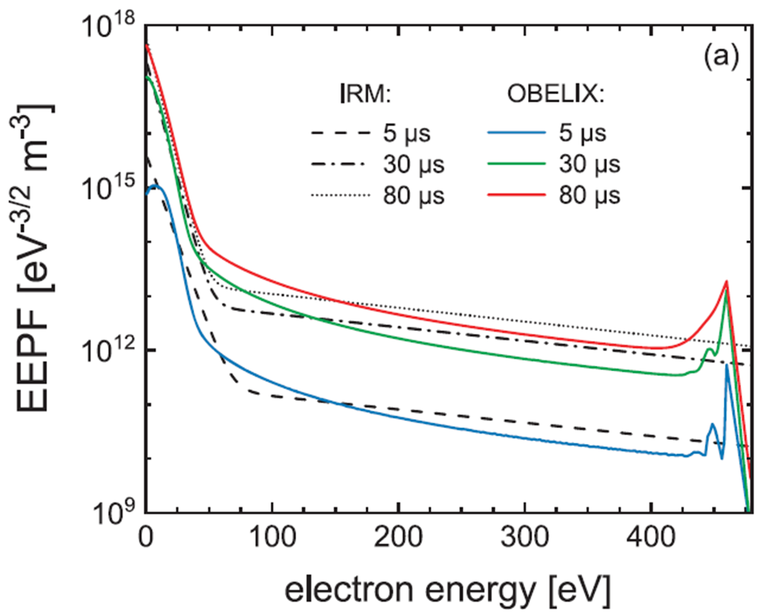Modeling of the magnetron plasma
contact : Tiberiu Minea & Adrien Revel
The magnetron discharge is widely used as an industrial device for ionising the precursors in thin film growth. This discharge has been the subject of fundamental research since its discovery over 50 years ago. The positive ions in the plasma are accelerated towards the cathode (or target), sputtering the atoms that compose it up. These atoms, originally neutrals when they become vapor, get ionized, pass through the plasma, and are deposited with neutrals (non-ionized sputtered species) on the anode (or substrate), creating a film. The specificity of the magnetron is the low working pressure due to addition of a magnetic field that effectively traps the electrons, thereby increasing the ionization rate of the gas (usually Argon) and the sputtered vapor.
For many years, the LPGP has been working to understand the various mechanisms governing the magnetron discharge, either in the dense plasma region or the transport of the sputtered material. One of the main difficulties lies in the inaccessibility of experimental measurements near the cathode, where the electric and magnetic fields are the strongest and the plasma of the highest density.
1. PIC-MCC Modeling
The PIC or Particle-In-Cell approach is a powerful method that numerically simulates plasmas or discharges in a self-coherent manner, i.e. considering the space charge (Coulomb repulsion, screening) and boundary conditions (electrodes). It is often coupled to a Monte Carlo Collision (MCC) method to describe the kinetic reactions such as ionization, diffusion or excitation.
The OHiPIC (Orsay High densityPartice-In-Cell) code uses these two coupled approaches (PIC-MCC) to model the plasma of magnetron discharges in the DC or pulsed regime. The code is parallelized, i.e. it can use several processors simultaneously, significantly increasing its efficiency and drastically reducing the computation time. It uses a more refined non-uniform mesh where the plasma is densest, while the projection and interpolation formulas can be second or third order, depending on the plasma.
This homemade 2D model provides microscopic detailed information on the magnetron plasma in the DC regime, as well as short pulses (5 µs) in HiPIMS (High Power Impulse Magnetron Sputtering) mode (800 V) [1].
2. Global kinetic modeling
The global approach to modelling a plasma describes the temporal evolution of parameters (species densities, temperatures, etc.), but averages them spatially. The plasma as a whole is assumed to be homogeneous, so these models are commonly referred to as dimensionless or 0D.
Two relatively different regions characterize magnetron plasma. The main region, which has a higher density and is responsible for kinetic reactions, is the ionisation region (IR). IR is defined by the magnetic trap just in front of the cathode. The region's most widely used kinetic model is called the IRM - Ionization Region Model [2]. The second zone corresponds to a diffusion plasma of lower density, characterized by the transport of particles from the target to the substrate.
The IRM model simultaneously solves for magnetrons, and particularly HiPIMS, the balance equations (creation vs. loss) for the main species making up the plasma (neutral or ionized gas, vapour from the target by sputtering, ionization of the vapour, creation of excited states, possible dissociation - if the gases are molecular, etc.) and the energy balance equation for the electrons in the plasma. These electrons can be considered to have a single temperature, or they can be made up of two populations depending on the origin of the electrons, each characterized by its temperature, in particular by distinguishing between the secondary electrons coming from the cathode by ion bombardment and accelerated in the sheath towards the plasma (energetic electrons) and the electrons (the majority) produced in the ionization region (so-called 'cold' electrons).
Recently, we validated the two-temperature approach by a direct comparison between the IRM model and the self-consistent solution of the Boltzmann equation for electrons in the magnetron plasma operated in HiPIMS mode using the OBELIX (Orsay Boltzmann equation for Electrons, Ions and eXcited states) model [2]. The very good agreement is shown in Figure 1 below. Also, these results agree with OHiPIC's ones [1].

Figure 1 – The OBELIX auto-coherent model (solid line) solution of the eedf showing two electron populations, with very different temperatures evolving during the pulse, in agreement with the IRM model (dotted line). [2]
3. Monte Carlo Modeling
The aim here is to model the transport of particles sputtered from the target. The trajectories of these particles are subject to collisions with the working gas. By matching the experimental and numerical fdv (velocity distribution function), it was possible to estimate the effective cross-section of metal-rare gas momentum transfer, particularly Ti-Ar. This work has led to a better understanding of titanium transport in an intermediate pressure regime, between ballistic (without collisions) and diffusive (governed by pressure gradients) and the thermalization process of sputtered particles [4].
